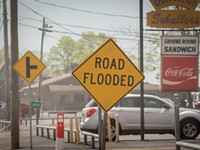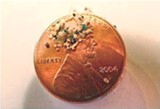[
{
"name": "500x250 Ad",
"insertPoint": "5",
"component": "15667920",
"parentWrapperClass": "",
"requiredCountToDisplay": "1"
}
]
Researchers have already confirmed the ubiquitous presence of tiny plastic pieces, called "microplastics," in several of the Great Lakes. Now a SUNY Fredonia professor says that she's found microplastics in Lake Ontario, too.
This summer, SUNY Fredonia associate professor of chemistry Sam Mason led a group of University at Buffalo students in collecting samples from Lake Ontario. In total, they collected 20 samples of lake water. And while the results haven't been analyzed yet, Mason says that she saw microplastics — pieces less than a millimeter in diameter — during visual inspections.
Previously, Mason and other researchers found and analyzed plastics pollution in Lakes Superior, Huron, and Erie.
Erie has the highest concentration of microplastics. But the new Lake Ontario samples, which were mostly collected along the lake's edge, appear comparable to Lake Erie, Mason says.
"We're finding the highest counts when we're close to shore," she says.
Mason says that she'll be able to make a better comparison once the Ontario samples are analyzed over the next six months. If the samples do reveal high concentrations of microplastics, researchers will probably collect more samples from the lake, possibly from farther out in the waters.
Mason and her students found some larger pieces of plastic in Lake Ontario, too, including a cigarette butt and a garbage bag tied to a balloon.
Researchers also revisited Lake Erie this summer to collect samples from other parts of the lake. And this month, Mason and researchers from the 5 Gyres Institute, which is known for its studies on plastics pollution in the oceans, are taking samples from Lake Michigan. The lake's waters haven't been analyzed for plastics pollution.
Mason says that she and her fellow researchers believe that microbeads — a type of microplastic — come from beauty products, such as exfoliating washes. Water treatment plants may be unable to filter out the beads, Mason says. Some companies have pledged to stop using the microbeads.
Ultimately, Mason says she wants to know whether fish, seabirds, and other aquatic animals are ingesting the plastics. And if so, what are the potential effects? Some toxic substances like pesticides will cling to plastic pieces.
SUNY Fredonia Professor Sam Mason led a group of students in collecting samples from Lake Ontario. And while the results haven't been analyzed yet, Mason says that she saw microplastics — beads less than a millimeter in diameter — during visual inspections.
Speaking of...
-

Calendar preview: Looking up
Aug 19, 2020 -

Earth Day: Events to celebrate home – from home
Apr 22, 2020 -

As Lake Ontario rises, IJC looks to deviate from Plan 2014
Apr 6, 2020 - More »
Latest in News
More by Jeremy Moule
-

ROCHESTER TEN
ANNETTE RAMOSAug 1, 2023 - More »





